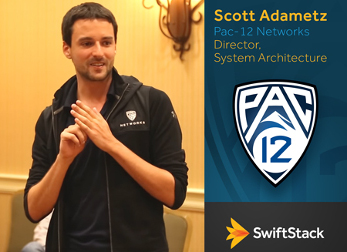Bridging the Streaming Video Storage Gap
$70.05 billion: That’s the projected value of the global video streaming market in 2021, according to the market research firm MarketsandMarkets. That is more than double the $30.29 billion that this same market was worth in 2016. Based on their research, MarketsandMarkets is predicting global streaming video’s CAGR (compounded annual growth rate) to be a staggering 18.3 percent. And 50 percent of this viewership is expected to take place on mobile devices.
Clearly, streaming video represents a tremendous profit opportunity for broadcasters and content providers alike. But this opportunity comes with a catch: To profit from it, broadcasters and content providers must create, support and serve massive amounts of programming from secure Web-connected video storage resources. This video storage must be efficient yet easy to manage; and able to respond to massive demand growth without requiring expensive, time-consuming upgrades.
Pac-12 Networks knows this dilemma all too well. As the media and TV company of the Pac-12 Conference, Pac-12 Networks broadcasts, streams and stores a full range of sporting events from 12 of the most prestigious U.S. universities. Pac-12 currently serves content to 60 million homes in the U.S. and 33 other countries, and provides live coverage of more than 850 college sports events annually to Fox and ESPN under a $3 billion, 12-year deal.

When Pac-12 Networks started operations in 2012, it handled its video storage/archiving needs using a two-tier Storage Area Network (SAN). Tier 1 had 100TB of storage capacity on fast 15krpm SAS drives for on-demand file retrieval and playout. Tier 2 had 200TB of slower SATA drives for archival footage required on a less-timely basis.
Sadly, this combined 300TB system proved too small for Pac-12's needs within six short months.
Not wanting to spend considerable time and money to expand its SAN, Pac-12 Networks opted to expand using cloud-based storage. But not just any cloud storage: Pac-12 Networks selected SwiftStack’s cloud-based hybrid storage solution.
Based on the OpenStack Swift object-based storage platform, SwiftStack allows content providers to quickly and effectively ramp up their video storage and streaming capabilities using whatever mix of web-based cloud and on-premises cloud storage that best suits their needs. SwiftStack is also designed to be controlled using a web browser interface; giving clients real-time access to the status, deployment, and usage of their video storage capacity around the clock.
The professional video industry's #1 source for news, trends and product and tech information. Sign up below.
At a per-terabyte storage price that was collectively 93 percentless than what it would have cost Pac-12 to expand their own SAN, SwiftStack provided the college sports powerhouse with a total of 2430 terabytes (2.43 petabytes) of raw cloud storage capacity within Pac-12's San Francisco data center. (More is available on demand at any time, within the cloud). That’s 8.1 times the capacity of Pac-12's original 300 TB SAN, at only 7 percent the per-terabyte cost of comparable SAN storage. Moreover, SwiftStack provided this solution within a tight schedule and without disrupting Pac-12 Networks’ ongoing operations.
“AWS is a strategic platform for Pac-12 Networks, enabling us to take advantage of cloud storage for offsite business continuity, as well for delivery of content to our OTT partners,” said Michael Harabin, vice president of technology, Engineering & Media Management at Pac-12 Networks. “Our data-intensive workloads will always benefit from on-premises storage like SwiftStack, where policy-based management of data in our architecture enables us to produce and better deliver our content to our fans.”
The result: SwiftStack has resolved Pac-12 Networks’ video storage issues, both for today and the foreseeable future. For broadcasters and content providers seeking to bridge their own growing video storage gaps, object-based storage is a solution worth considering.
Additional Resources
A detailed case study of SwiftStack’s deployment with Pac-12 Networks, with hard numbers on system performance and money saved.
SwiftStack Chosen by Vizrt as Viz One’s Default Storage
A blog entry detailing Vizrt’s decision to use SwiftStack as its default storage solution, for Vizrt’s popular Viz One media asset manager (MAM).
The SwiftStack Hybrid Storage Solution
A look at how SwiftStack’s hybrid storage solution works as part of a video production, storage, and playout system.
Pac-12 Networks Take on SwiftStack
Pac-12 Network’s Scott Adametz talks about SwiftStack’s hybrid storage solution, and what it has done for his company, including the ability to serve out 60 years’ worth of footage from Pac-12's SwiftStack storage on demand.
Details on SwiftStack’s hybrid storage solution.
